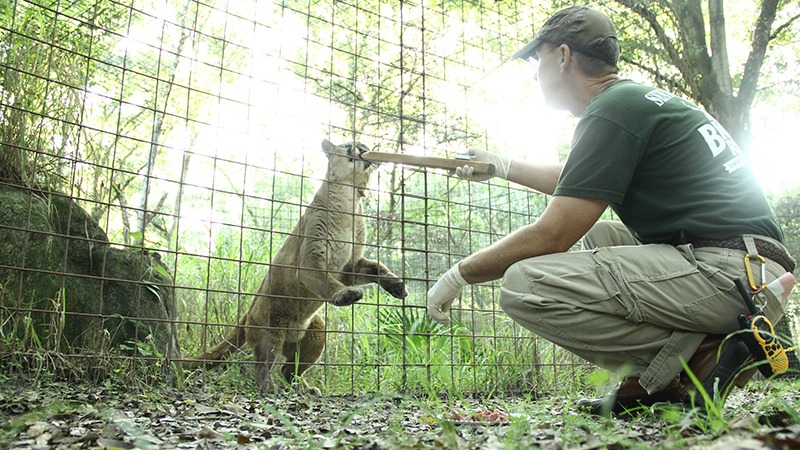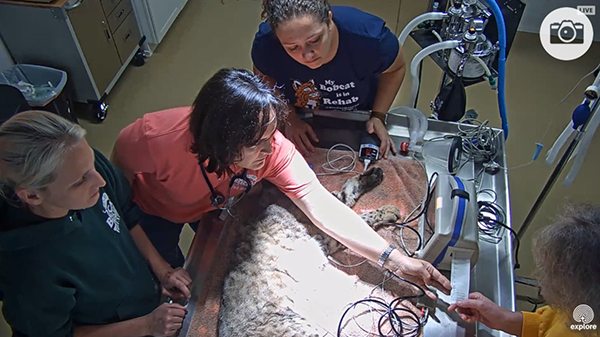Operant Conditioning Video
Operant Conditioning at Big Cat Rescue
Operant Conditioning: Big Cat Rescue’s Animal Training Program is based on operant conditioning. Operant conditioning is a type of learning in which behaviors are altered by the consequences that follow them. The behaviors are not forced, but “caught”, reinforced and therefore trained. We train only natural behaviors, no entertainment types of behaviors.
Operant Conditioning can:
Reduce the stress loads imposed by captivity
Enhance keeper safety
Facilitate routine care
Improve animal welfare
Enrich the animal and volunteer experience
Big Cat Rescue’s Operant Training Program is intended for:
Eliciting calm behavior from each of our animals while they are in the presence of their keepers and veterinary staff
Training behaviors that are dependable regardless of the trainer presentProviding mental stimulation for our animals
Enabling safe emergency and non-emergency transportation of the animalsProviding public education
Levels of Training: Big Cat Rescue’s Operant Training Program is broken into 3 certification levels. Volunteers and Interns are eligible to become certified to participate in Operant Conditioning with animals they are certified to feed.
The 3 levels are:
Small Cats (animals that Keepers & Interns 1-3 are certified to feed),
Big Cats Level 1 Cougars & Leopards (animals that Senior & Master Keepers and Interns 4-5 are certified to feed),
Big Cats Level 2 Lions & Tigers (animals that Senior &
Master Keepers and Interns 4-5 are certified to feed).
A Senior/Master Keeper or Level 5 Intern must have acquired six months of training in both big cat feeding and green level cougar & leopard operant training prior to being permitted to train Cheetaro the leopard.
Veterinary Care Training: Level 5 Interns, Senior Keepers, Master Keepers and Veterinarians will be participating in Veterinary Care Training. This training includes but not limited to; working with animals in the cat hospital or in quarantine, desensitizing animals to topical sprays, training target behaviors for specific veterinary procedures, working with veterinary care staff, training and observing Yellow Level trainers, and evaluating the animals and trainers progress.
General Guidelines:
Always check with the Coordinator prior to planning a session.
Training sessions should be well planned out before starting.
Training sessions will be logged on the Operant site on the .me site.
Training sessions should be short.
If an animal acts aggressively towards any trainer it is the trainer’s responsibility to discontinue working with that animal and to report the incident to the Coordinator.
Use only approved verbal and hand signals.
“No” is never to be used during training sessions. Never draw attention to errors. Ignore what you don’t want. Reward what you do want.If the animal is not cooperating step back and reset then resume training session. Do not repeat commands. Say it once and be patient.
Training sessions should be with a partner as often as possible. This will allow the animals to be accustomed to more than one person during the training sessions. This will also allow the other person to observe and to give their input on the session.
If there is more than one animal in a cage, two trainers must be present or the animals must be separated without causing stress.
Training sessions should take place when the environmental conditions are most favorable. Training sessions are not recommended in the rain or heat of the day.
Avoid food reinforcement immediately after feeding time. However training sessions shortly before feeding time can be the most productive.
Anytime we are feeding, interacting, cleaning, giving tours, etc we need to keep in mind that we are affecting how that animal interacts with us. Do not ever reward/reinforce bad behaviors.
We will need to work as a team for this program to work. Everyone will get to train animals they really like, but we need to make sure that the animals’ needs come before our needs.A master chart indicating each animal’s and trainer’s level of training will be maintained by the Operant Committee and will be posted on the Operant .me site.
Training Program: Ideally we would like to have all animals and eligible keepers participating and helping us achieve the goal of the Operant Training program. That goal is to make feeding and caring for the animals including observations, medical exams, and vet procedures as safe and efficient as possible. This program is designed with the animals’ and sanctuary’s needs in mind. This is a very strict program that requires a lot of dedication and work to ensure success. Trainers should be prepared to commit a minimum of 2 days per week to participating in this program.
Training Commands: Please use only the commands listed below. These are the approved commands that we will need for general husbandry.
Calling Animal to side of cage- Animal: Animal comes to the side of the cage and takes reward off the stick without swatting, stick biting, or any part of their body out of the cage. The goal is for the animal to stay with you and not get anxious or walk away until you are finished rewarding. Trainer: Trainer will use the operant stick to deliver reward. Since we have had some success with the clickers you can use the clicker to call the animal, do not use the clicker as a bridge (means of reinforcement).
DOWN – Animal: Animal should have all 4 feet on the ground inside the cage, crouched so belly and chest is on the ground. Animal should be sternal. Trainer: Verbal command “down” simultaneous with flat palm moving down. At the same time the trainer drops to one knee. Fingers should be closed, as with all hand signals hand should be well away from the cage and the reach of the animal.
LOCKOUT – Animal: Animal should have all 4 feet in the lockout and remain until given several treats or another command. (Running in and grabbing a treat and running out is progress towards but not considered lockout) Trainer: Verbal command given while pointing to or walking towards lockout
CLOSING ANIMAL IN LOCK OUT (2 trainer minimum at least one trainer must be a certified Green level trainer) – Animal: Animal comes into lockout stays calm while lockout door is shut. Trainer: One trainer focused on the animal, one trainer closing the lockout door. Make sure that when closing the lockout door the door is lowered slowly and safely so no animals extremities are closed in the door.
Food Size and Type: Be sure to adhere to dietary restrictions and special needs when choosing a type and size of meat for your operant session.





